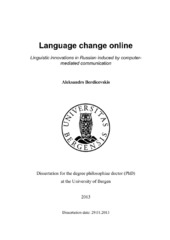| dc.description.abstract | In this dissertation, I study the role of computer-mediated communication (CMC) in language change. More precisely, I address the question of how speakers adapt their linguistic behavior to the constraints and affordances of the new communication channel, and whether changes in their behavior lead to the emergence of any innovations in the Russian language. In Chapter 2, I compare the linguistic variation in two communication channels: email and chat, demonstrating that for some variables there exist significant differences. I show that these differences can be explained by differences between the constraints and affordances of the two channels. In Chapter 3, I analyze a recent morphosyntactic innovation in Russian, the so-called “orthographic neuter”. I provide evidence for the fact that the successful diffusion of this innovation occurred in CMC, and would have been impossible without CMC. Chapter 4 has two aims. First, I describe some aspects of the so-called written turn, the trend towards greater autonomy and salience for written speech, reinvigorated by CMC. Second, I use this description as an example when addressing the well-known actuation problem of sociolinguistics and analyzing the role of CMC in actuating language change. I claim that most of the influence that CMC exerts on language change occurs not at the stage of individual speaker innovations, but at the stage of diffusion. In other words, CMC changes the selective forces that operate in language and determine which speaker innovations are likely to diffuse across society and which are not. In Chapter 5, I study how users play with conversation structure in quasi-synchronous CMC (chats and instant messengers). I use the methods of conversation analysis to elicit novel patterns of playful conversational behavior. Further, I analyze these playful, “anomalous” patterns in order to draw some conclusions about the “normal” management of conversation in quasi-synchronous CMC. In Chapter 6, I provide a quantitative description of the diachronic development of an online slang. The slang in question is the so-called “Olbanian language”, an orthographic anti-language, probably the most widely-known phenomenon in Russian CMC. I show how the frequency of use of anti-normative forms changes over a period of eleven years, both within and outside the Olbanian community. In the introductory Chapter 1, I discuss methodological issues, in particular, the danger of overestimating the role of CMC and ignoring other factors (i.e. the pitfalls of technological determinism). Further, I describe the general model of language change I adopt — “language as a complex adaptive system” — and provide an overview of the results of all five chapters from the standpoint of this model . | en_US |
